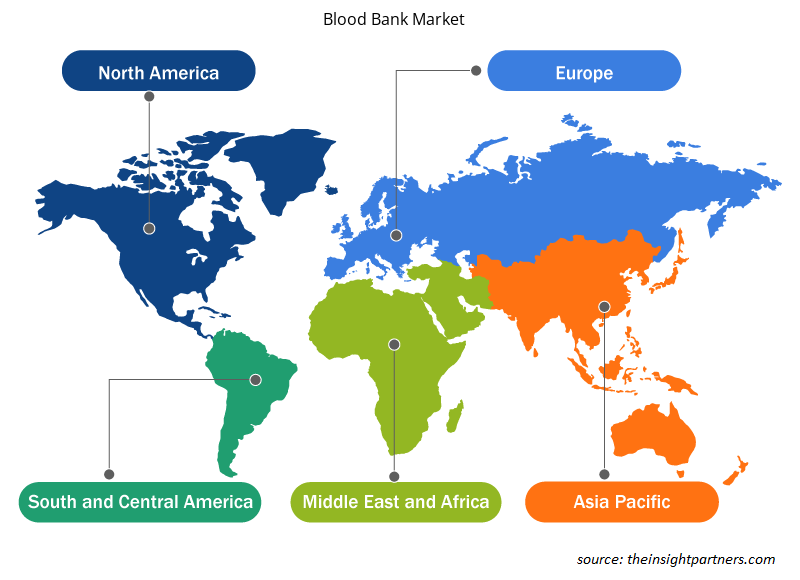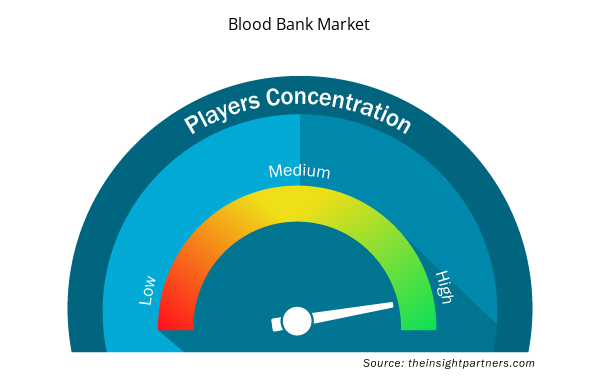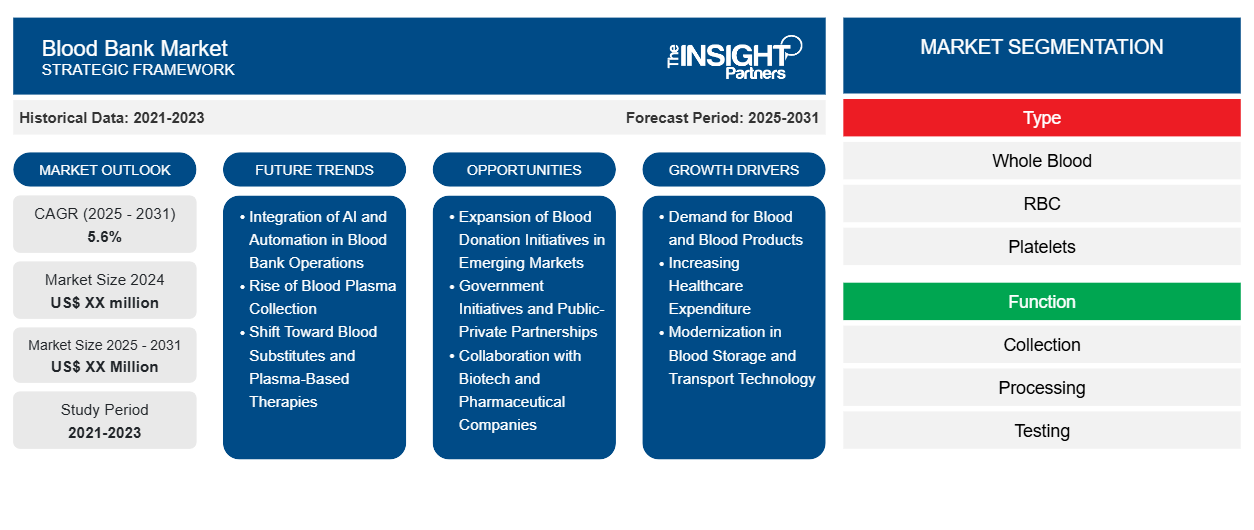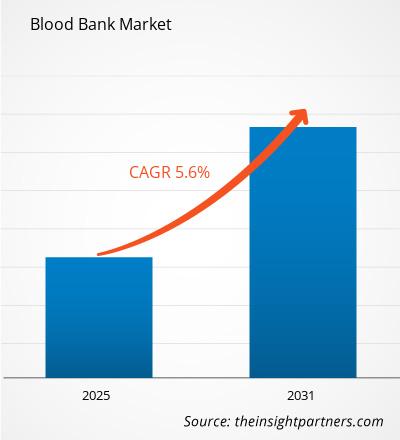Se espera que el mercado de bancos de sangre registre una CAGR del 5,6 % entre 2023 y 2031, con un tamaño de mercado que se expandirá de US$ XX millones en 2023 a US$ XX millones en 2031.
El informe de mercado de bancos de sangre ofrece una visión integral del mercado de bancos de sangre por función, tipo, usuario final y geografías. Los países y las regiones se presentan como un estudio de sectores para obtener una perspectiva global del mercado. Se presenta un tamaño de mercado estimado en dólares estadounidenses que da una idea de las tendencias del mercado, los impulsores del mercado y la competencia del mercado en varios segmentos. Este informe puede ser un gran recurso para que las partes interesadas comprendan cómo la industria de los bancos de sangre puede funcionar para usted y para usted.
Propósito del Informe
El informe Blood Bank Market de The Insight Partners tiene como objetivo describir el panorama actual y el crecimiento futuro, los principales factores impulsores, los desafíos y las oportunidades. Esto proporcionará información a diversas partes interesadas del negocio, como:
- Proveedores/fabricantes de tecnología: Para comprender la dinámica cambiante del mercado y conocer las oportunidades potenciales de crecimiento, lo que les permitirá tomar decisiones estratégicas informadas.
- Inversionistas: Realizar un análisis exhaustivo de tendencias sobre la tasa de crecimiento del mercado, las proyecciones financieras del mercado y las oportunidades que existen en toda la cadena de valor.
- Órganos reguladores: Regular las políticas y vigilar las actividades del mercado con el objetivo de minimizar los abusos, preservar la confianza de los inversores y defender la integridad y estabilidad del mercado.
Segmentación del mercado de bancos de sangre
Tipo
- Sangre entera
- glóbulos rojos
- Plaquetas
- Plasma
- CMB
Función
- Recopilación
- Tratamiento
- Pruebas
- Almacenamiento
- Transporte
Tipo de banco
- Privado
- Público
Usuario final
- Hospitales
- Centros de cirugía ambulatoria
- Compañías farmacéuticas
- Clínicas y residencias de ancianos
Usuario final
- Hospitales
- Centros de cirugía ambulatoria
- Compañías farmacéuticas
- Clínicas y residencias de ancianos
Personalice este informe según sus necesidades
Obtendrá personalización en cualquier informe, sin cargo, incluidas partes de este informe o análisis a nivel de país, paquete de datos de Excel, así como también grandes ofertas y descuentos para empresas emergentes y universidades.
- Obtenga las principales tendencias clave del mercado de este informe.Esta muestra GRATUITA incluirá análisis de datos, desde tendencias del mercado hasta estimaciones y pronósticos.
Factores impulsores del crecimiento del mercado de los bancos de sangre
- Demanda de sangre y productos sanguíneos: la creciente demanda de sangre y productos sanguíneos para cirugías, tratamientos de traumatismos, tratamientos oncológicos y partos es un factor de mercado importante para el mercado de los bancos de sangre. El suministro mundial de sangre es de 118,5 millones por año, según la Organización Mundial de la Salud (OMS), y la mayoría de los países aún sufren escasez de sangre, especialmente en el mundo en desarrollo. Esta creciente demanda requiere mejores instalaciones de almacenamiento, gestión y distribución de sangre y, en consecuencia, el mercado se está expandiendo.
- Aumento del gasto en atención sanitaria: los sistemas sanitarios de todo el mundo están experimentando un mayor gasto, especialmente en el área de atención de urgencias y cirugías, lo que a su vez aumenta la demanda de donaciones de sangre y servicios de bancos de sangre. Los gobiernos y los sectores privados están invirtiendo más en infraestructura sanitaria. Los bancos de sangre ayudan a garantizar la seguridad del suministro de sangre, lo que impulsa el gasto en tecnología e infraestructura.
- Modernización de la tecnología de almacenamiento y transporte de sangre: La industria de los bancos de sangre ha cambiado debido a los avances en la tecnología de almacenamiento, refrigeración y análisis. Las soluciones automatizadas de recolección y análisis de sangre y de cadena de frío que garantizan que los productos sanguíneos se almacenen correctamente extienden la vida útil y aumentan la eficiencia general de los bancos de sangre. Como destacó la Cruz Roja Estadounidense, la recolección y el análisis de sangre deben automatizarse para satisfacer la demanda y maximizar la eficiencia. Esta tecnología está impulsando la participación de mercado al brindar un servicio confiable.
Tendencias futuras del mercado de bancos de sangre
- Integración de la IA y la automatización en las operaciones de los bancos de sangre: una tendencia importante en el mercado de los bancos de sangre es la creciente adopción de la inteligencia artificial (IA) y las tecnologías de automatización. La IA puede ayudar en la detección de sangre, la predicción de la escasez de suministro de sangre y la optimización de la gestión del inventario. Los sistemas automatizados de recolección, procesamiento y análisis de sangre están reduciendo el error humano, acelerando las operaciones y mejorando la seguridad de la sangre. La mayor dependencia de la IA y la automatización seguirá impulsando el crecimiento en el mercado de los bancos de sangre al mejorar la prestación de servicios y reducir los costos operativos.
- Aumento de la recolección de plasma sanguíneo: la recolección de plasma sanguíneo es cada vez más común, impulsada por su uso en el tratamiento de una amplia gama de enfermedades, incluidos trastornos autoinmunes, quemaduras y casos de traumatismos. Los productos derivados del plasma, incluida la inmunoglobulina, son esenciales en los tratamientos médicos, lo que aumenta la atención en los centros de recolección de plasma.
- Cambio hacia los sustitutos de la sangre y las terapias basadas en plasma: Otra tendencia futura en el mercado de los bancos de sangre es el creciente enfoque en los sustitutos de la sangre y las terapias basadas en plasma. Si bien las donaciones de sangre siguen siendo fundamentales, se están desarrollando soluciones alternativas, como los sustitutos de la sangre sintéticos y las terapias derivadas del plasma, para abordar la escasez mundial de sangre. La Administración de Alimentos y Medicamentos de los Estados Unidos (FDA) ha aprobado varias terapias derivadas del plasma para tratar las deficiencias inmunológicas, lo que contribuye al crecimiento del mercado. Además, el aumento de los centros de donación de plasma, que han experimentado un aumento del 30% en la última década, está expandiendo el uso del plasma en terapias, lo que genera nuevas oportunidades de mercado para los bancos de sangre.
Oportunidades de mercado en los bancos de sangre
- Expansión de las iniciativas de donación de sangre en los mercados emergentes: Los mercados emergentes, en particular los de Asia y el Pacífico, África y América Latina, presentan importantes oportunidades de crecimiento para el mercado de los bancos de sangre. A pesar de la mayor concienciación, estas regiones se enfrentan a una grave escasez de sangre debido a la infraestructura inadecuada y a las limitadas campañas de donación. Según la Federación Internacional de Sociedades de la Cruz Roja y de la Media Luna Roja, más del 80% de las donaciones de sangre se recogen en países de altos ingresos, mientras que los países de bajos ingresos suelen carecer de los sistemas necesarios para recoger y almacenar suficiente sangre. Se espera que la inversión en campañas de donación de sangre, soluciones modernas de almacenamiento y sistemas de gestión de la sangre en las economías emergentes impulse una importante expansión del mercado en estas regiones.
- Iniciativas gubernamentales y asociaciones público-privadas: Las iniciativas gubernamentales y las asociaciones público-privadas ofrecen una oportunidad para ampliar aún más el mercado de los bancos de sangre. Los gobiernos colaboran cada vez más con organizaciones como la Cruz Roja y empresas privadas para mejorar los sistemas de recolección, almacenamiento y distribución de sangre. Las campañas de salud pública para fomentar la donación de sangre y mejorar la infraestructura han tenido éxito en el aumento del número de donantes y el suministro general de sangre. Por ejemplo, en la India, iniciativas gubernamentales como el Consejo Nacional de Transfusión de Sangre están ayudando a mejorar las tasas de recolección de sangre y la infraestructura. Se espera que estos esfuerzos impulsen el crecimiento del mercado de los bancos de sangre, en particular en países con recursos limitados.
- Colaboración con empresas biotecnológicas y farmacéuticas: las asociaciones entre bancos de sangre y empresas biotecnológicas o farmacéuticas para el desarrollo de productos sanguíneos avanzados, como sustitutos de la sangre o terapias basadas en células madre, ofrecen un potencial significativo.
Perspectivas regionales del mercado de bancos de sangre
Los analistas de Insight Partners explicaron en detalle las tendencias y los factores regionales que influyen en el mercado de bancos de sangre durante el período de pronóstico. Esta sección también analiza los segmentos y la geografía del mercado de bancos de sangre en América del Norte, Europa, Asia Pacífico, Oriente Medio y África, y América del Sur y Central.

- Obtenga los datos regionales específicos para el mercado de bancos de sangre
Alcance del informe sobre el mercado de bancos de sangre
| Atributo del informe | Detalles |
|---|---|
| Tamaño del mercado en 2023 | XX millones de dólares estadounidenses |
| Tamaño del mercado en 2031 | US$ XX millones |
| CAGR global (2023 - 2031) | 5,6% |
| Datos históricos | 2021-2022 |
| Período de pronóstico | 2024-2031 |
| Segmentos cubiertos | Por tipo
|
| Regiones y países cubiertos | América del norte
|
| Líderes del mercado y perfiles de empresas clave |
|
Densidad de actores del mercado de bancos de sangre: comprensión de su impacto en la dinámica empresarial
El mercado de bancos de sangre está creciendo rápidamente, impulsado por la creciente demanda de los usuarios finales debido a factores como la evolución de las preferencias de los consumidores, los avances tecnológicos y una mayor conciencia de los beneficios del producto. A medida que aumenta la demanda, las empresas amplían sus ofertas, innovan para satisfacer las necesidades de los consumidores y aprovechan las tendencias emergentes, lo que impulsa aún más el crecimiento del mercado.
La densidad de actores del mercado se refiere a la distribución de las empresas o firmas que operan dentro de un mercado o industria en particular. Indica cuántos competidores (actores del mercado) están presentes en un espacio de mercado determinado en relación con su tamaño o valor total de mercado.
Las principales empresas que operan en el mercado de bancos de sangre son:
- La Cruz Roja Nacional Estadounidense
- Vitalante
- Centro de sangre de Nueva York
- Corporación Terumo
- Sangre y trasplantes del NHS
Descargo de responsabilidad : Las empresas enumeradas anteriormente no están clasificadas en ningún orden particular.

- Obtenga una descripción general de los principales actores clave del mercado de bancos de sangre
Puntos de venta clave
- Cobertura integral: el informe cubre de manera integral el análisis de productos, servicios, tipos y usuarios finales del mercado de bancos de sangre, proporcionando un panorama holístico.
- Análisis de expertos: el informe se compila sobre la base de un profundo conocimiento de expertos y analistas de la industria.
- Información actualizada: El informe asegura relevancia comercial debido a su cobertura de información reciente y tendencias de datos.
- Opciones de personalización: este informe se puede personalizar para satisfacer los requisitos específicos del cliente y adaptarse adecuadamente a las estrategias comerciales.
Por lo tanto, el informe de investigación sobre el mercado de bancos de sangre puede ayudar a abrir camino para descifrar y comprender el escenario de la industria y las perspectivas de crecimiento. Si bien puede haber algunas preocupaciones válidas, los beneficios generales de este informe tienden a superar las desventajas.
- Análisis histórico (2 años), año base, pronóstico (7 años) con CAGR
- Análisis PEST y FODA
- Tamaño del mercado Valor/volumen: global, regional, nacional
- Industria y panorama competitivo
- Conjunto de datos de Excel



Report Coverage
Revenue forecast, Company Analysis, Industry landscape, Growth factors, and Trends

Segment Covered
This text is related
to segments covered.

Regional Scope
North America, Europe, Asia Pacific, Middle East & Africa, South & Central America

Country Scope
This text is related
to country scope.
Preguntas frecuentes
Some of the customization options available based on request are additional 3-5 company profiles and country-specific analysis of 3-5 countries of your choice. Customizations are to be requested/discussed before making final order confirmation, as our team would review the same and check the feasibility.
The report can be delivered in PDF/PPT format; we can also share excel dataset based on the request.
The American National Red Cross, Vitalant, New York Blood Center, Terumo Corporation, NHS Blood and Transplant, National Blood Transfusion Council, Sanquin, CSL, America's Blood Centers - are key players in blood bank market
The market is expected to register a CAGR of 5.6% during 2023-2031.
Blood bank market is driven by rising blood product demand, technology in blood storage and administration, as well as the availability of blood to ensure effective blood collection, testing and distribution infrastructure.
The future of the blood bank market is to incorporate AI and automation to improve efficiency, and more emphasis on blood substitutes and plasma therapies to treat blood shortage.
Trends and growth analysis reports related to Life Sciences : READ MORE..
1. The American National Red Cross
2. Vitalant
3. New York Blood Center
4. Terumo Corporation
5. NHS Blood and Transplant
6. National Blood Transfusion Council
7. Sanquin
8. CSL
9. America's Blood Centers
10. Canadian Blood Services
The Insight Partners performs research in 4 major stages: Data Collection & Secondary Research, Primary Research, Data Analysis and Data Triangulation & Final Review.
- Data Collection and Secondary Research:
As a market research and consulting firm operating from a decade, we have published and advised several client across the globe. First step for any study will start with an assessment of currently available data and insights from existing reports. Further, historical and current market information is collected from Investor Presentations, Annual Reports, SEC Filings, etc., and other information related to company’s performance and market positioning are gathered from Paid Databases (Factiva, Hoovers, and Reuters) and various other publications available in public domain.
Several associations trade associates, technical forums, institutes, societies and organization are accessed to gain technical as well as market related insights through their publications such as research papers, blogs and press releases related to the studies are referred to get cues about the market. Further, white papers, journals, magazines, and other news articles published in last 3 years are scrutinized and analyzed to understand the current market trends.
- Primary Research:
The primarily interview analysis comprise of data obtained from industry participants interview and answers to survey questions gathered by in-house primary team.
For primary research, interviews are conducted with industry experts/CEOs/Marketing Managers/VPs/Subject Matter Experts from both demand and supply side to get a 360-degree view of the market. The primary team conducts several interviews based on the complexity of the markets to understand the various market trends and dynamics which makes research more credible and precise.
A typical research interview fulfils the following functions:
- Provides first-hand information on the market size, market trends, growth trends, competitive landscape, and outlook
- Validates and strengthens in-house secondary research findings
- Develops the analysis team’s expertise and market understanding
Primary research involves email interactions and telephone interviews for each market, category, segment, and sub-segment across geographies. The participants who typically take part in such a process include, but are not limited to:
- Industry participants: VPs, business development managers, market intelligence managers and national sales managers
- Outside experts: Valuation experts, research analysts and key opinion leaders specializing in the electronics and semiconductor industry.
Below is the breakup of our primary respondents by company, designation, and region:

Once we receive the confirmation from primary research sources or primary respondents, we finalize the base year market estimation and forecast the data as per the macroeconomic and microeconomic factors assessed during data collection.
- Data Analysis:
Once data is validated through both secondary as well as primary respondents, we finalize the market estimations by hypothesis formulation and factor analysis at regional and country level.
- Macro-Economic Factor Analysis:
We analyse macroeconomic indicators such the gross domestic product (GDP), increase in the demand for goods and services across industries, technological advancement, regional economic growth, governmental policies, the influence of COVID-19, PEST analysis, and other aspects. This analysis aids in setting benchmarks for various nations/regions and approximating market splits. Additionally, the general trend of the aforementioned components aid in determining the market's development possibilities.
- Country Level Data:
Various factors that are especially aligned to the country are taken into account to determine the market size for a certain area and country, including the presence of vendors, such as headquarters and offices, the country's GDP, demand patterns, and industry growth. To comprehend the market dynamics for the nation, a number of growth variables, inhibitors, application areas, and current market trends are researched. The aforementioned elements aid in determining the country's overall market's growth potential.
- Company Profile:
The “Table of Contents” is formulated by listing and analyzing more than 25 - 30 companies operating in the market ecosystem across geographies. However, we profile only 10 companies as a standard practice in our syndicate reports. These 10 companies comprise leading, emerging, and regional players. Nonetheless, our analysis is not restricted to the 10 listed companies, we also analyze other companies present in the market to develop a holistic view and understand the prevailing trends. The “Company Profiles” section in the report covers key facts, business description, products & services, financial information, SWOT analysis, and key developments. The financial information presented is extracted from the annual reports and official documents of the publicly listed companies. Upon collecting the information for the sections of respective companies, we verify them via various primary sources and then compile the data in respective company profiles. The company level information helps us in deriving the base number as well as in forecasting the market size.
- Developing Base Number:
Aggregation of sales statistics (2020-2022) and macro-economic factor, and other secondary and primary research insights are utilized to arrive at base number and related market shares for 2022. The data gaps are identified in this step and relevant market data is analyzed, collected from paid primary interviews or databases. On finalizing the base year market size, forecasts are developed on the basis of macro-economic, industry and market growth factors and company level analysis.
- Data Triangulation and Final Review:
The market findings and base year market size calculations are validated from supply as well as demand side. Demand side validations are based on macro-economic factor analysis and benchmarks for respective regions and countries. In case of supply side validations, revenues of major companies are estimated (in case not available) based on industry benchmark, approximate number of employees, product portfolio, and primary interviews revenues are gathered. Further revenue from target product/service segment is assessed to avoid overshooting of market statistics. In case of heavy deviations between supply and demand side values, all thes steps are repeated to achieve synchronization.
We follow an iterative model, wherein we share our research findings with Subject Matter Experts (SME’s) and Key Opinion Leaders (KOLs) until consensus view of the market is not formulated – this model negates any drastic deviation in the opinions of experts. Only validated and universally acceptable research findings are quoted in our reports.
We have important check points that we use to validate our research findings – which we call – data triangulation, where we validate the information, we generate from secondary sources with primary interviews and then we re-validate with our internal data bases and Subject matter experts. This comprehensive model enables us to deliver high quality, reliable data in shortest possible time.


 Obtenga una muestra gratuita de este informe
Obtenga una muestra gratuita de este informe